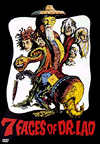7 Faces Of Dr. Lao (1964)
Warner Home Video
Cast: Tony Randall
Extras: Behind The Scenes Featurette, Theatrical Trailer, Production Notes
Rating:
"7 Faces of Dr. Lao, " George Pal’s compassionate adaption of Charles Finney’s 1935 cult novel about a mystical circus and its effect on a small Western town, has always been my favorite George Pal film. The story cuts just enough to make its point about human foibles but he suffuses the material with such tolerance and understanding that one might conclude Pal was thinly veiling a personal philosophical statement. Hopefully, Warner Home Video’s new DVD will bring "Lao" to the wide audience it deserves.
In adapting the rather episodic book, Pal and scripter Charles Beaumont took liberties with the original material, improving on it in the process. Tony Randall, under the multiple guises of William Tuttle’s Oscar-winning makeup, plays the mercurial but sage Dr. Lao as well as most of the roadshow’s mythological attractions. Within the circus tent, the townspeople of Abalone, Arizona encounter all manner of oddities and eccentricities, all the while unaware that each encounter with Lao’s "unbiological creatures" (as Finney coined them in the book) represents a chance at redemption or proof of self-condemnation.
The film’s larger ethical dilemma pits worldly but sensitive newspaper editor Ed Cunningham (John Ericson) against town "boss" Clinton Stark (Arthur O’Connell) with the few scraps of free minds left in Abalone hanging in the balance. Not present in the novel, this conflict serves an important purpose by reinforcing the notion, and I would imagine Pal’s hope, that we all have the capacity for overcome our frailties.
Finney’s scorn of small mindedness is much more absolute than Pal’s take on human folly. It’s no accident that Pal chose Charles Beaumont for the screenplay adaptation. Beaumont, one of the core writers on the original "Twilight Zone," was adept at the type of "magic realism" storytelling where everyday people encounter supernatural forces but face moral choices as well. He transformed Finney’s rather judgmental parable into a keenly observed but good-natured morality play. But I’ve said too much already. What surprises is not the unexpected turn of plot and story, but the gentle unfolding of life lessons that Lao offers the sleepy (in more ways than the obvious) town of Abalone.
I realize I am speaking in absolutes with no examples. Forgive me, but for those who have never seen the film I ask that you give this under-appreciated gem a try based solely on the vague ramblings of this humble reviewer. Yes, the film is hokey in spots and proudly wears its heart on its filmic sleeve, but if you’ve never seen the movie, you’re in for a REAL treat.
The DVD offers both full-frame and <$PS,widescreen> versions of the film. Despite video companies trumpeting that "kids don’t care about aspect ratios," the decision to include both options on the same disc is a welcome one. Both transfers accurately captures the "storybook" color scheme, saturating hues with earth tones as a visual extension of the agrarian roots of all fairy tales. Deep, deep blacks vividly draws out details in the image, again especially highlighting Randall’s extraordinary transformations. I have never seen the film look better. Despite graininess during the process shots (owing to the film technology back then), the source itself looks very clean. I saw it in a theater back in 1975 and the print was in such poor condition, it barely made it through the projector.
From a composition standpoint, the full-frame adds a little more headroom and cuts off a sliver on the sides. The 1.85 <$16x9,anamorphic> image looks more compositionally correct in terms of elements within the frame. Personally, I preferred the full-screen version because I have a 4×3 TV right now and filling the screen allows greater detail in watching Lao’s for today’s TVs as well as tomorrow’s.
The soundtrack sounds good for its age. Presented in <$DD,Dolby Digital> mono, there are no distortions or peaks during the loud passages (which are few) and Leigh Harline’s score comes through clear and crisp.
A six-minute promotional reel, "William Tuttle, King of the Duplicators" rounds out the disc’s only real supplement. A very contrived exploration of how make-up prosthetics are created, the reel shows Tuttle working on a life mask. Photos of some of Tuttle’s creations (including before and after photos of Randall in the Lao makeup) accompany the narration. The small but bright consolation is Tuttle displaying some of the life masks he’s made for the classic MGM stars like Fred Astaire, Clark Gable and Van Heflin. A theatrical trailer and liner notes on George Pal and Tony Randall round out the extras. A minor quibble, but just a simple video interview with Tuttle or Randall talking about "Lao" from today’s perspective would have made the disc perfect. The special features are programmed for each side, making both the full-frame and <$PS,widescreen> versions complete presentations.
Watch "7 Faces of Dr. Lao" in whatever shape screen pleases you. Afterwards, if you walk outside and see the world with a little more humanity and a little more magic, then the film and the charity it inspires will have fulfilled its collective purpose.
As a companion disc to "Lao" and the other George Pal DVDs now available, I strongly recommend checking out Arnold Leibovit’s thorough documentary "The Fantasy Film Words of George Pal." The section on "Dr. Lao" offers the insight that the DVD unfortunately lacks.







